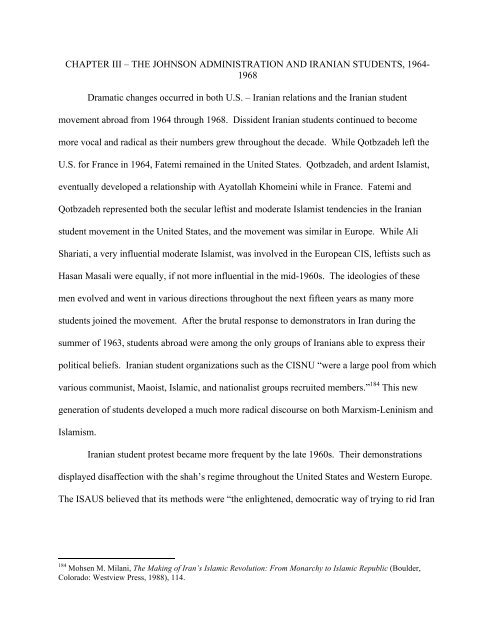AN AUGURY OF REVOLUTION: THE IRANIAN STUDENT ...
AN AUGURY OF REVOLUTION: THE IRANIAN STUDENT ...
AN AUGURY OF REVOLUTION: THE IRANIAN STUDENT ...
Create successful ePaper yourself
Turn your PDF publications into a flip-book with our unique Google optimized e-Paper software.
CHAPTER III – <strong>THE</strong> JOHNSON ADMINISTRATION <strong>AN</strong>D IR<strong>AN</strong>I<strong>AN</strong> <strong>STUDENT</strong>S, 1964-<br />
1968<br />
Dramatic changes occurred in both U.S. – Iranian relations and the Iranian student<br />
movement abroad from 1964 through 1968. Dissident Iranian students continued to become<br />
more vocal and radical as their numbers grew throughout the decade. While Qotbzadeh left the<br />
U.S. for France in 1964, Fatemi remained in the United States. Qotbzadeh, and ardent Islamist,<br />
eventually developed a relationship with Ayatollah Khomeini while in France. Fatemi and<br />
Qotbzadeh represented both the secular leftist and moderate Islamist tendencies in the Iranian<br />
student movement in the United States, and the movement was similar in Europe. While Ali<br />
Shariati, a very influential moderate Islamist, was involved in the European CIS, leftists such as<br />
Hasan Masali were equally, if not more influential in the mid-1960s. The ideologies of these<br />
men evolved and went in various directions throughout the next fifteen years as many more<br />
students joined the movement. After the brutal response to demonstrators in Iran during the<br />
summer of 1963, students abroad were among the only groups of Iranians able to express their<br />
political beliefs. Iranian student organizations such as the CISNU “were a large pool from which<br />
various communist, Maoist, Islamic, and nationalist groups recruited members.” 184 This new<br />
generation of students developed a much more radical discourse on both Marxism-Leninism and<br />
Islamism.<br />
Iranian student protest became more frequent by the late 1960s. Their demonstrations<br />
displayed disaffection with the shah’s regime throughout the United States and Western Europe.<br />
The ISAUS believed that its methods were “the enlightened, democratic way of trying to rid Iran<br />
184 Mohsen M. Milani, The Making of Iran’s Islamic Revolution: From Monarchy to Islamic Republic (Boulder,<br />
Colorado: Westview Press, 1988), 114.















